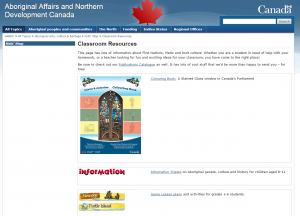Having narrowed down my research question onto the use of Aboriginal voices in digital media in classrooms, I have been able to focus my research a little better over the past couple of weeks. This week I have been looking particularly at how story fits into all strands of the curriculum; there are many teachers who feel the Aboriginal perspective doesn’t fit into their curriculum because they “don’t teach that unit”. Rather than a “one and done” approach, I would like to look at how stories told from the Aboriginal perspective in the voices of First Nations peoples can be woven through our classroom work particularly in science and math. The resources I have found this week include:
- Highlighting Aboriginal perspective in the classroom seems like an easy first step for teachers. Some of the unease for teachers remains in differentiating between when we are highlighting culture and when we are teaching religion, an uncomfortable distinction for many teachers, which often leads to simply ignoring the topic. An easy first step seems to be the integration of the Aboriginal perspective in the science classroom. APTN Kids provides teachers with bilingual links to powerful, research-based programing like Coyote Science and here that demonstrate that including the Aboriginal perspective in classrooms is as fundamental as the characters in the story. When Coyote helps to explain science concepts, includes a joke of the week and the medicine wheel is included in the set design, students see a valuable perspective. This is a good example of what happens when the First Nations perspective is woven through the resources used in the classroom.
- Show Me Your Math is a site developed by Lisa Lunney Borden and supported by her doctoral research that highlights the Aboriginal perspective in math learning. It highlights inquiry learning for students related to math that begins with authentic artifacts and continues through the use of authentic voices in telling the stories of the artefacts and the related math.
- My former board of education, the Regina Board of Education developed a list of resources related to an Indigenous calendar. The thinking being that teachers weave First Nations teachings into the curriculum throughout the year rather than viewing it as a stand-alone unit of teaching. The book Aboriginal Success in the Classroom highlight the fact that a First Nations perspective is just that: a lense for viewing classroom work.
- Two Eyed Seeing in the Classroom is an analysis of how the Aboriginal perspective can be highlighted in science classrooms. The paper explores how “Indigenous Sciences are underlain by the perception of multiple realities at that reality perceived by our five senses is but one of those.” (Cajete, 2000)
- Aboriginal Perspectives in Teaching Science from the University of Regina highlights the importance of First Nations stories and the role of Aboriginal Elders in the science classroom as essential guides for teachers in integrating this approach. The paper discusses the importance of understanding the philosophical underpinnings of the story and how story can be misunderstood and the lesson miscommunicated if the teller doesn’t fully understand the story.
In the next few weeks, I will continue to seek examples of stories told digitally and how they are being used in classrooms.
